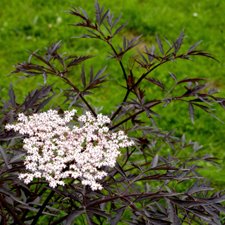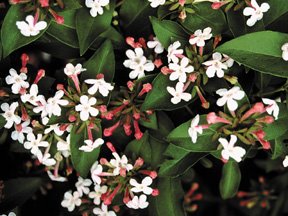 Black Lace™ (Sambucus nigra ‘Eva’ pp# 15,575)
Black Lace™ (Sambucus nigra ‘Eva’ pp# 15,575)
The appeal of Black Lace is its unique black leaf color that sets it apart from all other plants. Plants with black leaves are few and far between, especially for the perennial garden. In the array of shrubs it is nearly non-existent. Not only does it portray this characteristic, but many others. Its fine texture and lacy look is comparable to that of a Japanese Maple. For the novice gardener, it would be easy to get them confused. One way that it can be distinguished is the fact that Black Lace has beautiful pink blooms in early Spring & Summer. Then in the Fall it produces dark black berries that can be used for making wine and jam or for attracting wildlife. It is also multifunctional as a stand alone accent plant, mixed in a perennial and annual border, container gardening or as a hedge. It is exceptionally hardy and will do well from Central Minnesota to North Carolina and west to California (Zones 4 to 7).
For More New plants visit the ColorChoice Website
 Abelia mosanensis
Abelia mosanensis
This relatively rare Abelia is worth looking for if you enjoy fragrance in the garden.
It is a noteworthy because unlike any other Abelia it is highly fragrant, and very hardy - Zone 4.
I obtained this plant from a Latvian woman I met in Germany. I do not speak German or Russian, and she did not speak English but by pointing to some images and using botanical latin names I was able to show my interest in obtaining some plants. With the help of email, a translator and fedex I had this wonderful plant within six months.
Abelia mosensis as it turns out is actually a Korean native. It forms its flower buds in autumn and blooms in spring. The buds appear reddish-pink and the open to white. The fragrance is as good as Hyacinths or Korean Spice Viburnum. It is a most delightful plant to have in the garden.
The plant is a large, somewhat loose plant with glossy simple leaves that matures around 6ft. In the Autumn the foliage turns shades of orange and red.
We introduced this plant some 5 years ago and it is loved by all who have grown it.
For More Information on Cool New plants visit the ColorChoice Website


